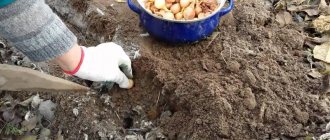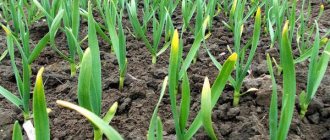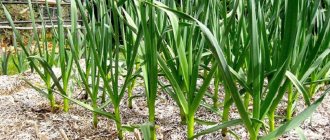Winter garlic is always planted in the fall, so that after winter you can start harvesting it as early as possible. However, the current winters come so late and are so unstable that garlic often has time not only to take root before the cold weather, but also to germinate.
It is known that garlic is a fairly winter-hardy crop. But even despite this, its tender upper part, which appears on the surface of the earth, simply will not tolerate frost and will die. Of course, garlic will not lose its ability to “throw out” feathers, but its harvest will not be at all what you expected. To prevent this from happening, the winter crop that has sprouted in the fall must be immediately protected from the coming cold.
When to plant winter garlic in the fall
The main task of a vegetable grower growing winter crops is to correctly determine the planting time. The garlic cloves are immersed in the not yet frozen soil, where they must have time to take root before the onset of severe cold. In this case, the above-ground part should not appear above the surface of the earth until spring. The safety of the crop in winter and the volume of the harvest next year depend on proper planting.
For your information! Winter varieties of garlic are planted in the garden when the average daily air temperature drops to 4-6 °C, and no more than 30 days remain before the arrival of permanent frosts.
Garlic is the most popular vegetable
Deadlines for different regions of the country
Depending on the climate of a particular area, winter vegetables in Russia are planted from September to November. Approximate planting dates in the regions:
- Middle zone, Moscow region - second ten days of October;
- Leningrad region, middle and southern Urals - early October;
- northern Urals and Siberia - September;
- in the southern regions, garlic should be planted in November.
The weather in certain areas of one region can differ significantly (the range of temperature differences can reach 15 ° C). Planting dates can shift in any direction by 1-2 weeks. The gardener should first of all focus on the weather forecast and the timing of planting garlic in his area.
For your information! The experience of our ancestors also comes to the aid of the vegetable grower. Peasants in Rus' began planting winter garlic cloves after the leaves fell. When the trees in the forest were completely exposed, this served as a signal for the imminent arrival of frost. They also paid attention to migratory birds; as soon as the cranes formed a wedge and flew away, they began to prepare the beds for crops.
The bed for garlic is prepared 7-12 days before sowing the crop. This time is enough for the excavated soil to settle and compact and dissolve the applied fertilizers in it.
Is it necessary to shift planting dates during warm autumn?
In recent years, the climate on the planet has been changing towards warming. Old dates for planting winter plants are no longer relevant in many regions. Warm and rainy autumn provokes rapid growth of the above-ground part of garlic. Sprouts may emerge before the onset of frost and suffer from the cold.
A gardener needs to know the weather forecast for at least a month in order to determine a favorable time for sowing. In the event of an extensive warm cyclone, garlic sowing is postponed for a couple of weeks.
Note! If a long thaw is expected, you can keep the temperature inside the ground low and prevent the plant from sprouting by filling the bed with snow. If it is not enough, the frozen soil is covered with sawdust.
Proper garlic bed
Where to plant garlic?
To grow garlic on your own plot, you must first decide on the location of the beds in which it will grow. This herbaceous plant is quite picky when choosing a location. If you decide to grow garlic in open ground, then you definitely need to prepare fertile soil.
Garlic
Note! When choosing a place where garlic beds will be located, it is worth remembering that this crop prefers small hills. If you plant garlic in a lowland, then it will be harmed by the abundance of moisture that accumulates in such areas.
The beds should be located in an open area so that the plant is well ventilated. Planting garlic in the fall, done in open ground, must also take into account the fact that in winter snow should completely cover the ground. A lack of snow will cause the plant to freeze and die. Let's consider what other requirements the place for planting garlic must meet:
- periodic presence of ice crust in winter;
- distance from paths;
- protection from pets.
Garlic needs to be planted in dry places, so you need to determine areas suitable for this purpose in advance. It is recommended to monitor the areas in which water accumulates on the site and avoid them.
How does covering beds affect the emergence of early seedlings?
Recommendations for sowing winter garlic note the positive effect of mulch on the successful wintering of the plant. In northern and middle latitudes, there is a high risk of cloves freezing in winter if you do not cover the bed with loose material. Under a layer of mulch of 15-20 cm, the soil does not freeze below −8 °C.
However, when long warm weather sets in, favorable conditions for garlic germination are created in the soil under the shelter. The feathers of the plant may come to the surface ahead of schedule.
Attention! To avoid premature emergence of crops, insulate the bed after the first frost sets in. When the air temperature drops to −8 °C, begin mulching the garden.
The soil, covered after the top layer has frozen, preserves the cloves like in a thermos at a constant low temperature.
Preparing beds for planting garlic
Before you start planting winter garlic, you need to prepare the beds. It is recommended to start it in August. First of all, you should remember that the area selected for planting garlic should not have the remains of previous plants. If there are any, then the soil should be cleaned.
Land preparation
The soil in the planting area must be fertilized. Various means are used for this, but there are also irreplaceable ones, for example, copper sulfate. After fertilizing the required area, it is recommended to cover it with plastic wrap. It is removed only before planting garlic.
Note! It is recommended to plant in the morning (after a frosty night). Before starting work, it is worth removing the top layer of soil. Then the bed should be fertilized with a solution of potassium permanganate, which has a beneficial effect on crop growth.
Additional work can be done to prepare the beds. Experienced gardeners use mulching to protect garlic from severe frosts. The ground can be insulated with sawdust or dry peat, but you should not lay out too thick a layer of material. For good development of garlic, it is recommended to cover the ground with a layer whose width is approximately 2 cm. In cold regions (for example, Siberia), you can increase the layer of sawdust or other material used for mulching.
In any case, the preparation of the beds largely depends on the individual weather conditions of a particular area. Don't forget that frosts may come earlier or later than usual.
How sprouted garlic will feel in spring
Winter garlic is quite frost-resistant. If the bed with seedlings that appeared in the fall was thoroughly insulated, such plants will not differ from those that sprouted in the standard time frame.
If southern (not winter-hardy) varieties were planted before winter and the seedlings were not covered, the chances of a successful outcome are low. The sprouts may freeze completely, and the clove will not sprout again. The crop will have to be replanted.
If the feather is partially frozen (only the tops are frostbitten), then you can help the plant recover. What to do if winter garlic sprouted in the spring with a frozen feather:
- when the air temperature has risen to 10-12 °C, the greens are sprayed with an aqueous solution of epin, zircon;
- at the end of April - beginning of May, the row spacing is loosened and the garlic is fed with mineral fertilizer.
The growth stimulator and fertilizer have a complex effect on plants, strengthening the immune system and stimulating growth.
Feeding seedlings will give a chance for their resuscitation
Caring for Garlic
Monitoring the conditions in which a crop grows is no less important than planting it correctly. In winter, the weather does all the work. There are no special recommendations for caring for garlic at this time of year. The main work begins only after the snow melts.
The first thing you need to do after the soil in the beds has grown is to weed the soil. The loosened soil will help the garlic sprouts break through to the surface. In addition, this operation will allow the roots to receive the oxygen necessary for proper growth of the crop.
Important! Garlic does not tolerate high humidity, so even during dry periods you should not water the plant every day. It is best to supply the plant with water once every 14 days.
After the culture produces arrows, it is necessary to remove them. Removing the arrows is very simple: pull them out by hand. If you leave the arrows, then a large amount of nutrients will go into them. Proper care of the crop in the spring is very important, so do not ignore these recommendations.
When to harvest? Harvesting is most often done after the leaves of the plant turn yellow. Experienced gardeners recommend digging up ripe heads of garlic in dry weather.
Proper planting of garlic in the fall requires compliance with a number of rules, such as: choosing a location, preparing beds for winter and caring for them. To prevent the plant from deteriorating, it is necessary to focus on individual weather conditions in a particular region. Garlic cloves grown in your own garden will be a great addition to many dishes.
Write in the comments: What tips can you give for planting garlic in the fall and growing it?
Features of planting in autumn step by step instructions
The basic steps for planting garlic are relatively simple. Most gardeners prefer to first properly prepare the site:
- Choose a place where there will be enough light. Preferably not in lowlands and not after harvesting onions, garlic, and potatoes.
- 1-1.5 months before planting (August, early September) add fertilizer.
- The area is dug up to a depth of 20-30 cm. Garbage and debris are removed from the ground.
- The soil is leveled and watered periodically (if it rains, there is no need to water).
Next, the garlic itself is prepared and planted:
- Before planting, the bulbs are disassembled, collected and sorted according to the size of suitable cloves for planting.
- You can soak the cloves for 10-30 minutes in solutions: potassium permanganate, copper sulfate, salt or purchased fungicidal agents.
- Holes or grooves are prepared on the site. Between the rows you need to maintain about 30 cm. Between the cloves on the beds - up to 10 cm.
- The cloves are carefully manually planted with the bottom down. It is important to maintain approximately a planting depth of 10-12 cm under the top layer of soil.
- The beds are filled and watered.
- From above, the area is mulched with straw, tops or leaves until spring.
Planting garlic cloves
How to prepare and process garlic cloves before planting
Before planting garlic in the ground, the bulbs are separated into individual cloves. This must be done very carefully, trying to minimize or completely eliminate damage to the protective husk of each clove.
It is better not to use damaged cloves for planting.
The bottom is the lower part of the cloves, from which the root system of the plant begins to form. In exceptional cases, you can use a sharp knife, but very carefully, to remove the cork coating from the bottom without damaging it. This is done when it is necessary, due to unfavorable weather forecasts or delays, to help the crop take root as quickly as possible.
If a variety without arrows is selected, then only the outer cloves are suitable for planting.
Preparing garlic cloves for planting
Not all summer residents resort to treating the cloves before planting. However, disinfection of planting material can hardly be called an unnecessary step. Processed garlic is better resistant to disease, rot and pests.
You can give preference to the following solutions for treating cloves:
- The product "Fitospirin-M", prepared according to the instructions. Soaking time: no more than 10 minutes.
- Maxim solution according to instructions, but for about 15 minutes.
- Fundazol solution according to instructions. For 5-10 minutes.
Or prepare the solution yourself:
- Dissolve 10 g. copper sulfate in 1 liter. water. Soak for about 15 minutes.
- In a weak solution of potassium permanganate. Up to 30 minutes, as the product is weak.
- Dissolve 2 tbsp. spoons of table salt per 1 liter. water. Soak the cloves for 30 minutes.
In which month is it better to plant garlic before winter?
Summer residents have a question: in which month is it better to plant garlic before winter? But there is no single answer here. Russia is a large country with several climatic zones. Therefore, the month for planting vegetables must be selected individually.
On the day of planting, the air temperature warms up to approximately 10-12 degrees Celsius. Frosts are scheduled to begin in 2-3 weeks.
Accordingly, in the warmer regions of our country (Kuban, Crimea, Caucasus) this is October, in the Middle Zone (Black Earth Region, the capital region) - the last days of September - the first ten days of October, and in the Urals and Siberia - the second half of September or in good years the beginning October.











